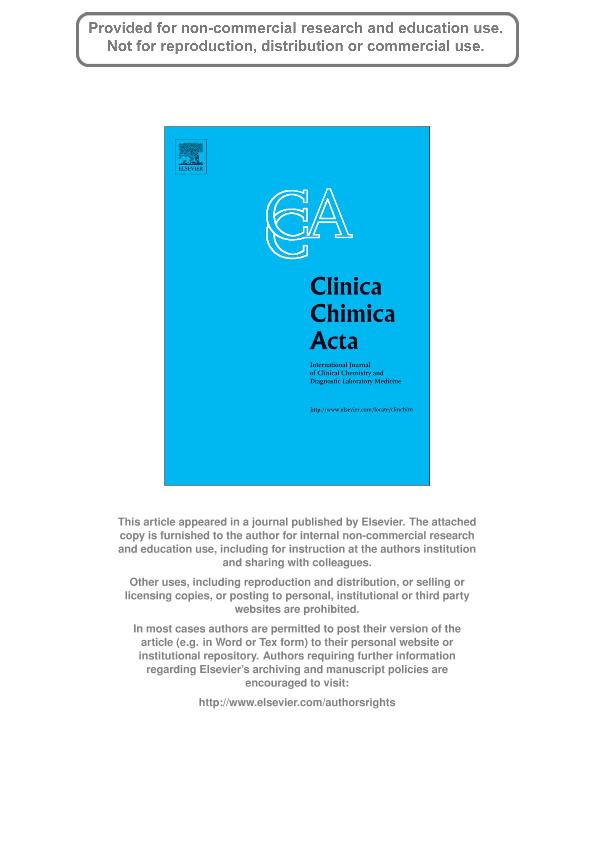Artículo
Improving arylsulfatase activity determination in dried blood spots: screening and diagnostic approaches for Maroteaux–Lamy syndrome (MPS VI)
Franco, Paula Gabriela ; Perez, Maria Julia
; Perez, Maria Julia ; Aranda, Claudio; Adamo, Ana María
; Aranda, Claudio; Adamo, Ana María ; Silvestroff, Lucas
; Silvestroff, Lucas
 ; Perez, Maria Julia
; Perez, Maria Julia ; Aranda, Claudio; Adamo, Ana María
; Aranda, Claudio; Adamo, Ana María ; Silvestroff, Lucas
; Silvestroff, Lucas
Fecha de publicación:
06/2015
Editorial:
Elsevier
Revista:
Clinica Chimica Acta
ISSN:
0009-8981
Idioma:
Inglés
Tipo de recurso:
Artículo publicado
Clasificación temática:
Resumen
BACKGROUND: Mucopolysaccharidosis type VI can be screened by measuring the lysosomal arylsulfatase B (ARSB) residual enzyme activity in dried blood spots (DBS) using synthetic substrates. However, we have found experimental obstacles when determining ARSB activity with the fluorescent method due to the significant quenching effect rendered by DBS components. METHODS: We adapted the methods originally described by Chamoles et al. [1] and Civallero et al. [2] and put forward 2 distinct approaches for ARSB activity quantification from DBS samples by measuring the 4-methylumbelliferone (β-MU) fluorescence generated from the ARSB 4-methylumbelliferone sulfate (β-MUS) substrate. RESULTS: We demonstrate the high throughput feasibility of a novel approach for measuring ARSB activities by incorporating tailor-made calibration curves according to each patient's DBS sample quenching properties. The second method is used to calculate ARSB activities by measuring the fluorescence and absorbance parameters in each reaction sample with a single DBS-free calibration curve. CONCLUSIONS: The quantitative correlation between the DBS sample absorbance and its quenching effect can be used to calculate predictive ARSB activities and would serve as an affordable first tier screening test. The method described herein demonstrates the critical importance of adapting the β-MU calibration curves to each patient's unique DBS sample matrix and its positive impact on the accuracy and reliability of ARSB activity measurements.
Archivos asociados
Licencia
Identificadores
Colecciones
Articulos(IQUIFIB)
Articulos de INST.DE QUIMICA Y FISICO-QUIMICA BIOLOGICAS "PROF. ALEJANDRO C. PALADINI"
Articulos de INST.DE QUIMICA Y FISICO-QUIMICA BIOLOGICAS "PROF. ALEJANDRO C. PALADINI"
Citación
Franco, Paula Gabriela; Perez, Maria Julia; Aranda, Claudio; Adamo, Ana María; Silvestroff, Lucas; Improving arylsulfatase activity determination in dried blood spots: screening and diagnostic approaches for Maroteaux–Lamy syndrome (MPS VI); Elsevier; Clinica Chimica Acta; 446; 6-2015; 86-92
Compartir
Altmétricas



